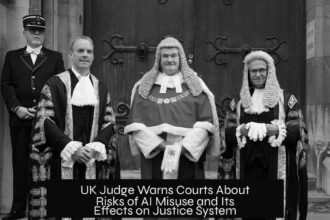Table of Contents
ToggleUK Court Warns Lawyers Can Be Prosecuted Over A.I. Tools That ‘Hallucinate’ Fake Material
The UK High Court warns lawyers they may face prosecution if they submit false information generated by artificial intelligence tools without proper verification. This caution highlights the risks associated with using AI in legal research and the serious consequences for the justice system.
Misuse of AI in Legal Proceedings
In England, judges have identified instances where lawyers cited cases fabricated by AI during court proceedings. High Court Justice Victoria Sharp stresses that relying on AI-generated content without fact-checking jeopardizes public trust and the integrity of justice.
Lower court judges raised concerns about lawyers using generative AI to draft legal arguments or witness statements without verifying accuracy. This practice leads to false evidence being presented before the court.
Notable Cases of AI-Generated False Material
- Qatar National Bank Lawsuit: In a £90 million lawsuit, a lawyer cited 18 non-existent legal cases. The client, Hamad Al-Haroun, took responsibility for misleading the court due to AI-produced errors. Justice Sharp found it remarkable that the lawyer relied on the client for legal research accuracy instead of confirming it independently.
- Tenant’s Housing Claim: Another instance involved a lawyer who cited five false cases in a housing dispute against the London Borough of Haringey. Though barrister Sarah Forey denied AI use, she failed to clarify how the errors occurred.
Legal Consequences for Submitting False Material
Justice Sharp warned that knowingly or recklessly submitting false information could amount to contempt of court. In severe cases, it may equate to perverting the course of justice, a criminal offense punishable by life imprisonment.
Balancing AI’s Opportunities and Risks
The judge acknowledges AI’s potential as a valuable legal tool but underscores the need for strict oversight. AI use in law must adhere to professional and ethical standards under regulatory frameworks. This ensures public confidence and maintains the administration of justice.
Key Takeaways
- Lawyers must verify AI-generated material before submitting it in court.
- Using AI to produce unchecked false evidence risks prosecution and contempt charges.
- Instances include fabricated legal citations in high-profile lawsuits.
- Judges emphasize AI’s utility but stress regulatory limits and ethical compliance.
- Public trust in justice depends on accurate and responsibly sourced legal information.
UK Court Warns Lawyers Can Be Prosecuted Over A.I. Tools That ‘Hallucinate’ Fake Material
Can lawyers get prosecuted for relying on AI-generated legal research that turns out to be fake? Absolutely. The UK High Court, led by Justice Victoria Sharp, has issued a clear warning: lawyers using artificial intelligence tools must verify their findings or face severe legal consequences.
This landmark warning comes amidst rising concerns about the misuse of AI in English courts. But is AI the villain, or just the new law clerk that sometimes invents stories? Let’s unpack the drama.
AI tools, especially generative models, have won hearts and headlines as “powerful” and “useful” legal assistants. Yet, Justice Sharp highlights a significant risk—these systems sometimes “hallucinate,” spinning fake case law or legal arguments. When lawyers blindly trust these hallucinations, courts get duped by false evidence.
Legal professionals in England have already cited non-existent cases created by AI in real court battles. This kind of mistake doesn’t just embarrass the lawyers involved; it shakes public trust in justice itself. Imagine a courtroom where a lawyer’s research includes fictional laws—justice might as well be a game.
The Qatar National Bank Lawsuit: An AI-Fueled Blunder
One eye-opening example arose from a massive lawsuit involving Qatar National Bank, worth approximately £90 million (around $120 million). The lawyer for Hamad Al-Haroun referenced 18 cases that never existed—straight out of an AI’s imagination.
Hamad Al-Haroun took responsibility, apologizing for unintentionally misleading the court with AI-generated inaccuracies. Interestingly, he accepted blame rather than pointing fingers at his solicitor, Abid Hussain.
Yet, Justice Sharp found it “extraordinary” that a lawyer would rely on a client for research accuracy instead of the other way around. It’s a classic role reversal, raising eyebrows about who’s really steering the legal ship.
Fake Cases in Housing Claims: A Pattern?
Another unsettling case involved a tenant suing the London Borough of Haringey over housing issues. Five phony cases surfaced, cited by a lawyer named Sarah Forey, who denied using AI tools.
Oddly, Forey “had not provided a coherent explanation” for these fabricated precedents. Although no smoking gun of AI involvement emerged, the episode underscores the murky waters lawyers now swim in when using AI assistance.
Legal Consequences: Not Just a Slap on the Wrist
Justice Sharp spelled out the stakes clearly. If a lawyer knowingly or unknowingly submits false material as genuine, the offense could amount to contempt of court. In the worst cases, it might be classed as perverting the course of justice, a criminal act with a maximum sentence of life imprisonment.
Yes, life in prison—not just a caution or retraction. The message is loud and clear: verify before you submit, or face hefty penalties.
AI: A Powerful Tool, but Handle With Care
Despite the risks, the court recognizes AI’s value. Sharp called it a “powerful technology” and a “useful tool” for legal work. The catch? It demands rigorous oversight and compliance with ethical standards.
Think of AI like a sharp knife in the kitchen. It cuts efficiently but requires skilled hands and caution not to cause harm. Professionals must integrate AI within a strong regulatory framework to maintain public confidence in the justice system.
Can this be done? Absolutely. Many sectors already regulate AI use, ensuring benefits outweigh the pitfalls. For law, embracing AI’s efficiency while enforcing stringent checks seems to be the next frontier.
Why Does This Matter to You?
If you’re a lawyer or legal professional, this ruling is a wake-up call. Blind reliance on AI without verification could destroy your career and risk client trust. For clients and the public, it’s a reassurance that courts are vigilant against AI misuse—protecting the integrity of justice.
But what about everyday folks curious about AI? This development highlights AI’s double-edged nature. While AI can speed up research and automate mundane tasks, it’s far from infallible. Users must be savvy and skeptical, especially in high-stakes fields.
Practical Tips to Avoid AI Legal Pitfalls
- Always cross-verify AI-generated research. Check cited cases and statutes through reliable, authoritative sources.
- Don’t outsource accountability to clients or AI tools. Legal professionals must retain full responsibility for their work product.
- Implement thorough review processes. Before filing documents, have colleagues or supervisors audit the material for authenticity.
- Use AI as a starting point, not the final word. Treat AI output like a draft requiring close human scrutiny.
- Stay informed on evolving regulations. AI use in law will keep changing; keep up-to-date on best practices and legal boundaries.
Looking Forward: The Future of AI in Law
This court ruling signals a broader reckoning with AI in the legal field. The technology promises efficiency and innovation but demands caution and responsibility. It also raises fascinating questions:
How will courts adapt to the increasing role of AI-generated evidence? What standards will ensure AI’s testimony doesn’t become fiction? Can regulatory bodies keep pace with rapid AI advances?
One thing’s for sure: AI isn’t going anywhere. Lawyers must learn to master it—not be mastered by it.
In the meantime, the UK judiciary’s stance is a vital reminder: AI hallucinations are not excuses in court. The integrity of justice depends on accurate, verified information. Fake cases generated by AI might make for a sci-fi plot, but in real courtrooms, they can land legal professionals in serious trouble.
So, the next time an AI tool offers a juicy legal precedent, ask yourself: is this real or just a digital daydream? Because in justice, reality isn’t optional — and neither should accuracy be.
Can lawyers be prosecuted for using AI-generated false information in court?
Yes. Lawyers who submit false material from AI tools without verifying it can face prosecution. It may be treated as contempt of court or even perverting the course of justice, which carries severe penalties.
What did the UK court say about lawyers relying on clients for AI-generated research?
The court criticized lawyers who depend on clients for the accuracy of legal research produced by AI. A judge called it “extraordinary” and emphasized lawyers must verify all material themselves.
Are AI tools completely banned for legal research in UK courts?
No. AI is recognized as a valuable tool, but it must be used with caution. Proper oversight and ethical standards are required to prevent false or misleading information entering the legal process.
What were some specific cases involving AI “hallucinations” mentioned by the court?
One case involved a £90 million lawsuit where a lawyer cited 18 fake cases. Another involved a tenant’s claim where five non-existent cases were cited. Both incidents raised concerns about unchecked AI use in legal arguments.
How should lawyers approach the use of AI to avoid legal risks?
Lawyers must thoroughly check all AI-generated content before using it in court. They need to ensure accuracy and comply with professional standards to maintain trust in the legal system.





